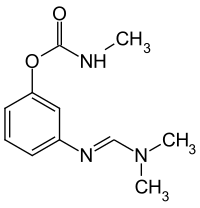Formetanat
| Structural formula | |||||||||||||||||||
|---|---|---|---|---|---|---|---|---|---|---|---|---|---|---|---|---|---|---|---|

|
|||||||||||||||||||
| General | |||||||||||||||||||
| Surname | Formetanat | ||||||||||||||||||
| other names |
|
||||||||||||||||||
| Molecular formula | C 11 H 15 N 3 O 2 | ||||||||||||||||||
| Brief description |
colorless to yellowish solid with a faint odor |
||||||||||||||||||
| External identifiers / databases | |||||||||||||||||||
|
|||||||||||||||||||
| properties | |||||||||||||||||||
| Molar mass | 221.26 g mol −1 | ||||||||||||||||||
| Physical state |
firmly |
||||||||||||||||||
| density |
0.5 g cm −3 |
||||||||||||||||||
| Melting point |
200–202 ° C (decomposition) |
||||||||||||||||||
| Vapor pressure |
0.0016 mPa (25 ° C) |
||||||||||||||||||
| pK s value |
8.0 |
||||||||||||||||||
| solubility |
|
||||||||||||||||||
| safety instructions | |||||||||||||||||||
|
|||||||||||||||||||
| Toxicological data | |||||||||||||||||||
| As far as possible and customary, SI units are used. Unless otherwise noted, the data given apply to standard conditions . | |||||||||||||||||||
Formetanate is a chemical compound from the group of amidines and carbamates .
Extraction and presentation
Formetanate can be obtained by reacting m- aminophenol with dimethylformamide , phosphorus oxychloride and methyl isocyanate under the action of hydrochloric acid .
properties
Formetanat is a colorless to yellowish solid with a faint odor. It decomposes when heated above 200–202 ° C. In the soil, under the action of UV light and in solution, the compound decomposes rapidly, with 3-aminophenol and formaminophenol , among others, being formed, depending on the decomposition conditions .
use
Formetanate is used as an insecticide and acaricide against spider mites and some insects ( Diptera , Hemiptera and Thysanoptera ) in fruits, vegetables and alfalfa . It is a weak cholinesterase inhibitor. Formetanat was approved in the FRG between 1969 and 1991.
The compound hit the headlines when residues were detected in strawberries in 2008, the amount of which, however, was harmless according to the Federal Institute for Risk Assessment.
Admission
Formetanat has been approved for use as an insecticide and acaricide in the European Union since October 2007. In Germany and some southern European countries there are approvals for preparations with formatanat. No pesticides containing this active ingredient are permitted in Austria or Switzerland.
Individual evidence
- ^ A b Stanley A. Greene: Sittig's Handbook of Pesticides and Agricultural Chemicals . William Andrew, 2005, ISBN 0-8155-1903-6 , pp. 477 (English, limited preview in Google Book search).
- ↑ a b c d e f g h Entry for CAS no. 22259-30-9 in the GESTIS substance database of the IFA , accessed on December 15, 2012(JavaScript required) .
- ^ Entry on Formetanate in the Pesticide Properties DataBase (PPDB) of the University of Hertfordshire , accessed on December 17, 2013.
- ↑ a b c d Terence Robert Roberts: Metabolic Pathways of Agrochemicals: Part 2: Insecticides and Fungicides . Royal Society of Chemistry, 1999, ISBN 0-85404-499-X , pp. 46 ( limited preview in Google Book search).
- ↑ Entry on Formetanate in the Classification and Labeling Inventory of the European Chemicals Agency (ECHA), accessed on August 1, 2016. Manufacturers or distributors can expand the harmonized classification and labeling .
- ↑ Formetanate hydrochloride data sheet , PESTANAL at Sigma-Aldrich , accessed on October 16, 2016 ( PDF ).
- ↑ Thomas A. Unger: Pesticide Synthesis Handbook . William Andrew, 1996, ISBN 0-8155-1853-6 , pp. 83 (English, limited preview in Google Book search).
- ↑ Peter Brandt: Reports on Plant Protection Products 2009: Active Ingredients in Plant Protection Products ... Springer, 2010, ISBN 3-0348-0028-2 , p. 18 ( limited preview in Google Book search).
- ↑ Federal Institute for Risk Assessment: No acute health risk from formetanate in strawberries - BfR opinion No. 021/2008 of May 7, 2008 (pdf; 56 kB)
- ↑ Directive 2007/5 / EC of the Commission of February 7, 2007 amending Council Directive 91/414 / EEC to include the active substances captan, folpet, formetanate and methiocarb
- ^ Directorate-General for Health and Food Safety of the European Commission: Entry on Formetanate in the EU pesticide database; Entry in the national registers of plant protection products in Switzerland , Austria and Germany ; accessed on December 6, 2019.


